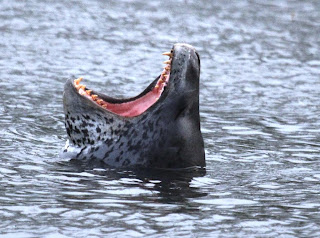Now I’ve covered most of the birds, it’s onto the non-bird
animals, namely the seals! It is continuing to be a good year for Leopard seal
sightings. In May we sighted Leopard seals on 25 occasions, compared to last year’s
four sightings. Each of the seals are given a name and in May we saw; Max,
Paddy Boy, Stephanie (my name sake), Maurice, and Pearce. Hannah our resident
seal expert has been out every day patrolling the beaches for sightings. Most
of the time they aren’t particularly hard to spot lying on the beaches, or head
standing (sleeping vertically in the water with their flippers sticking up).
Sometimes we even get to witness them eating, which involves lots of splashing
and failing about. It’s not only the human residents of the island who are on
the lookout for them eating. As soon as the birds notice a kill they surround
the seal trying to grab any pieces. It’s a fairly dangerous occupation but
usually the seal is too busy eating to pay attention to the birds. June was another productive Leopard seal month
with 20 sightings. Pearce the seal was first spotted here 22 years ago when he
was already an adult, that is one old seal! Hannah managed to retrieve a second
GLS logger from a seal, which is very exciting as it is only the fifth to ever
be retrieved. I’ll update with where they have been once the data is analyzed.
 |
| Sleepy Leopard seal on the beach. |
July has seen a few less sightings but in recent days the
number have picked up again. This morning whilst sitting on the jetty a Leopard
seal swam over looking at us curiously until a Fur seal jumped in the water and
it took off after it. The seal got away as he was a bit too big for the Lep to
handle.
 |
| Maurice in the bay yawning (photo by Hannah Wood) |
Antarctic Fur seal numbers have been increasing on the
island again, with some of the big males returning to the island, after being
at sea for a few months feeding up following the breeding season. You can
definitely tell they are back from the smell! They have a very strong musky
odour that you just can’t get away from when walking on the beaches. The
numbers are still fairly small, we can still walk along the beaches without
getting chased very much.
 |
| A female Antarctic Fur seal |
One of the less pleasant aspects of our job is to help seals
that have been entangled in fishing gear. This week we were all involved in
helping a young male that had a thick layer of parcel tape wrapped tightly
around his body. After a bit of a struggle and getting pretty soggy socks we managed to cut through
the tape. The rest of it should now fall off when he is swimming. It’s very
satisfying to remove debris from the seals, as in most cases the seal would die
when it grew too big and the debris cuts into it. Happy story this time. I just
wish people would think about what they discard into the ocean.
 |
| Young male Antarctic fur seal after we had cut the tape from his chest. |
The Elephant seals are still hanging out on the beaches
lying on piles of rotting kelp. A couple of weeks ago we had our first
large(ish) male. He didn’t have the typical big nose, but he was huge! Later in
the season we might get some fully grown adult males (fingers crossed).
 |
| The big elephant seal male with me for scale (Photo by Craig Brown). |
 |
| Elephant seal relaxing on a bed of stinky rotting kelp. |
Seals done, it’s onto whales. Usually by this time of year
the Southern Right Whales have migrated north from this area, but for some
reason they are still here. We have sighted them off the southern side of the
island on a number of occasions recently. The easiest way to identify them when
they are quite far out to the sea is by what the blow looks like when they
breathe out. Southern rights have a V-shaped blow, which is very distinctive.
They could possibly be around because of the higher than average water and air
temperatures. Hannah and I saw one very close to the cliffs the other day but
it wasn’t in the mood to perform any tricks and didn’t show us its tail.
So mammals completed, it’s back to birds. Over the winter
period myself and Jerry (the other bird nerd) count Snowy Sheathbill and South
Georgia Pintails (ducks) every couple of weeks. The counts correspond with the highest
tides, and we count the same area as was done last year. The reason for the
counts is to assess if the rat eradication programme that was carried out this
year is having any effects on the birds. Duck numbers seemed very low, but all of a
sudden the ducks have made a comeback, and they are often heard beeping (they
have a very weird electronic beeping call) through the night.
 |
| Snowy Sheathbill scavenging on a Gentoo penguin carcass. |

No comments:
Post a Comment